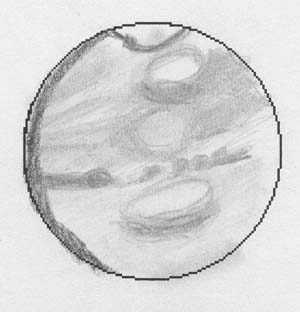
Sketched July 25, 2003 from Glacier Point, Yosemite National Park midnight pacific DST (daylight savings time) or 07:00 UT. Outstanding observing night from 11:00 p.m. to 12:00 midnight. Transparency LM 6.8, seeing perfect. It was difficult to sketch with so many people wanting to look through the 7-inch refractor.
| Date: 07/25/03 Lat 37N, Long 119W, elev. 7,200 feet | Sketch Time (UT): 7:00, (local time): midnight DST |
| Central Meridian: 16° | Filters: none |
| Instrument: 7.1-inch (180mm) f/9 Astro-Physics Starfire Apo refractor. | Distance from earth 0.44 AU, 66m km, 41m miles |
| Magnification: (16mm) 300x Zeiss Abbe Orthos combined with a 2.4x AP Barcon Barlow | Transp. 6/6, Seeing 10/10, Antoniadi (I-V): I |
| Apparent Size: 21.1" | Magnitude: -2.1 |
South Polar Cap notch and dark melt line continue to be prominent. Chryse should be closer to the north polar region in my sketch - maybe I'll redo the sketch. I noticed a blue haze over the north polar area on the next 4 observing sessions (July 25, 26, 27, 28). Sinus Sabaeus and Sinus Meridiani (on zero meridian, get it?) are the long dark feature. Light areas from south (top) to north (bottom) are: South polar cap, Argyre, Pyrrhae Regio and Chryse. The north polar cap is not visible - the planet's south hemisphere is tilted toward earth, but a cloud formation called the north polar cloud is visible. The little "dots" are part of Aurorea Sinus, and Tithonius Lacus.
Mars, in this sketch is reversed N/S. South is shown at the top of the image. The south polar cap is the prominent feature, and shows a notch that was quite distinct to me. Terminator is where daylight ends and evening begins. The terminator is on the left and the planet is rotating left to right. In my sketches the planet rotates Martian east (left) to west (right) to match most other images and sketches. Look for features rotating from left to right in the drawings from night to night.
Details about Mars: Diameter 21.1 arc seconds (Jupiter is about 30 -50 arc seconds in diameter depending on its distance from earth). Central Meridian 16 - the imaginary line passing through the planetary poles of rotation and bisecting the planetary disk, and is used to determine the longitude during an observing session.

White Oaks Home | Sketches Index | Mars 2003 Index | Back | Next